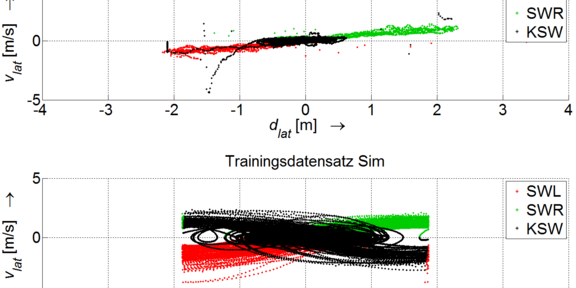Comparison of Real and Simulation Data on Lane Change Prediction for Highway Driving


To disburden human drivers in certain driving scenes by taking over the driving task (SAE level 2 to 4) or to release him entirely from driving (SAE level 5), the automated vehicle needs to be able to solve particular traffic situations independently and reliably. The final link in the entire process chain that the automated driving stack builds, is the maneuvering and control part. It is the part that is recognized by the passengers of automated vehicles. The first link of the chain, the perception part, may be visible externally by means of specific sensors, such as camera, radar, or lidar. The largest and most complex part of the process chain is software which is invisible and not directly observable by the passengers, too. For passengers, these software modules may only be experienceable indirectly by means of the overall driving behavior. One central link of the chain is the motion prediction of surrounding traffic participants. Due to vehicle to vehicle interactions the theoretical motion and action space of the automated vehicle is permanently and continuously restricted. These limitations result from either direct occupation of certain spaces by other traffic participants or by prohibition due to safety and comfort issues caused by these vehicles. The earlier and more precise the future motion of other traffic participants can be estimated, the more foresighted (which directly translated to safer and more comfortable) the automated vehicle can plan and adjust its own future motion trajectory.
Highway driving situations are characterized by a high degree of structure (parallel driving lanes separated by lane markings which define the legitimacy of changes between those lanes) and allow for some simplifications, such as the absence of cross traffic. Therefore, a relatively simple classification of lane change maneuver state of vehicles enables a comparatively accurate prediction of the future motion state of those vehicles. In driving situations described above, simple models for the longitudinal dynamic (such as assuming constant velocity or acceleration) yield acceptably accurate predictions along the main direction of motion. Therefore, the remaining variability for motion prediction is framed as recognizing the correct lane change state of the relevant vehicles. So, lane change prediction is considered as a multi-class classification problem distinguishing the three following classes lane change to the left (LCL), lane change to the right (LCR), and lane keeping (NLC/LK). As input features time series data of several kinematic states of the relevant vehicles as well as so called situation-based features are used. The situation-based features characterize the relation of kinematic states between two neighboring vehicles. On the one hand, real-world data is characterized by great variability of observed driving situations but on the other hand is degraded by sensor effects such as noise and occlusion. Therefore, it seems to be meaningful to substitute or complement real-world data with simulation data to enhance the size of the available data by “ideal” data. In this work we investigate how real-world and simulation data should be combined ideally to get the best possible lane change prediction algorithm. In this work, an additional focus is put on developing expressive and use-case specific metrics for evaluation lane change predictions.

![[Translate to English:] [Translate to English:]](/storages/zentraler_bilderpool/_processed_/8/b/csm_Kopfbild_Orga_Luftbild_9523d53350.jpg)